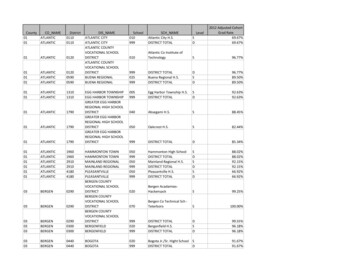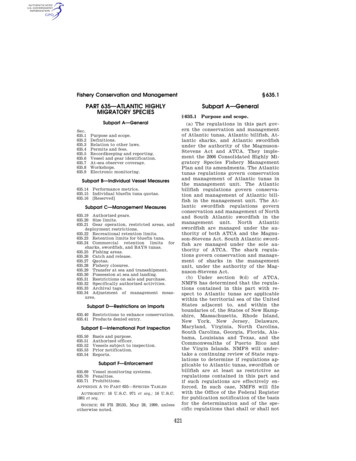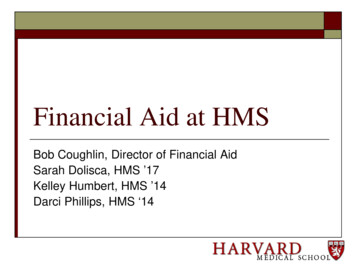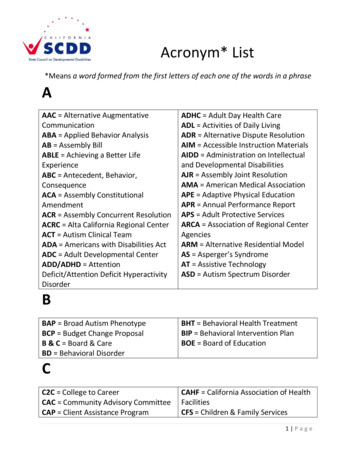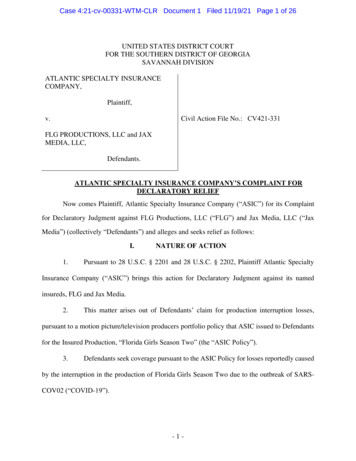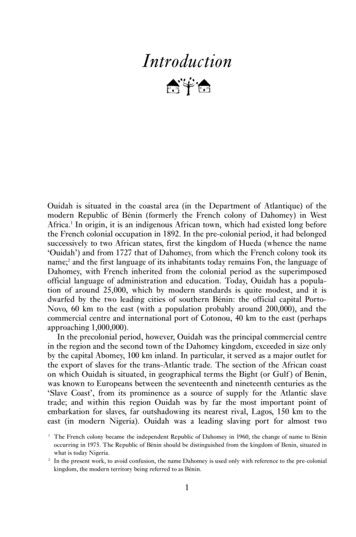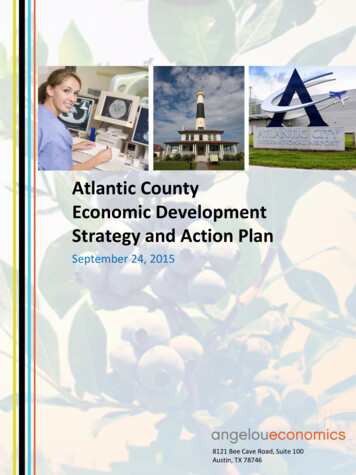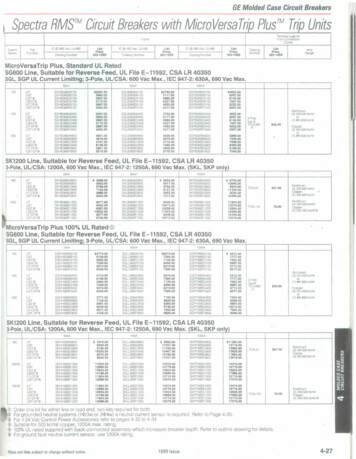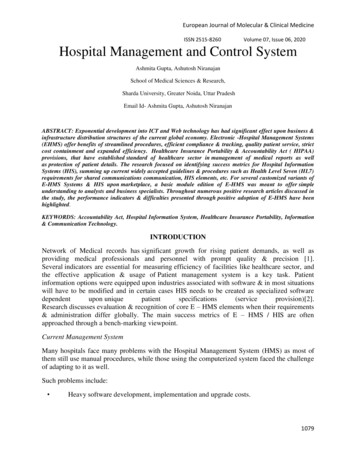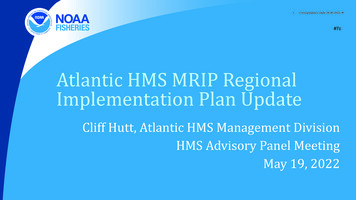
Transcription
1.Correspondence (June 28-30, 2022) M#7cAtlantic HMS MRIP RegionalImplementation Plan UpdateCliff Hutt, Atlantic HMS Management DivisionHMS Advisory Panel MeetingMay 19, 2022
MRIP Regional Implementation Plans The purpose of the Regional ImplementationPlans is to identify regional recreational datainformation needs and recommendations forprogrammatic improvements Primary focus is on MRIP and the Large PelagicsSurvey (LPS), but the Atlantic HMS Plan is also anopportunity to conduct a comprehensiveexamination of all sources of HMS recreationaldataPage 2 Atlantic HMS Plan was first developed in 2017U.S. Department of Commerce National Oceanic and Atmospheric Administration National Marine Fisheries Service
Goals for Today’s Discussion Page 3Update the AP on NOAA Fisheries progress towards implementing thepriorities of the 2017 PlanPut forth agency ideas for additional improvements to existing and newpotential HMS data collectionsSolicit input from the AP on additional recreational data needs andprioritiesU.S. Department of Commerce National Oceanic and Atmospheric Administration National Marine Fisheries Service
Atlantic HMS Recreational Data NeedsBasic scientific and management data needs remain unchanged, but changes in thefisheries may necessitate changes in data collectionRecreational Tuna Fisheries Mid-Atlantic and New England tuna fisheries starting earlier, and lasting longer into the fall (LPS coveragequestion, currently June to October)Billfish and Recreational Swordfish Fisheries Improvement in technology allowing deep-drop fishery to expand Still need to re-establish MRIP in the CaribbeanRecreational Shark Fishery Amendment 14: active management of recreational shark fishery Current ability to quantify shore-based fishing for large sharks, especially at nightPage 4Increasing reports of shark depredation in the recreational fisheryU.S. Department of Commerce National Oceanic and Atmospheric Administration National Marine Fisheries Service
Major Changes in HMS Recreational Data Collections LPS entering final year of pilot testing new design MRIP has fully transitioned to the Fishing Effort Surveywith new data standards coming in 2023 For-hire logbook reporting now required for allCouncil-permitted vessels in Atlantic and Gulf ofMexico, but not HMS Charter/Headboat Selection for HMS tournament reporting expanded toPage 5all tournaments, and 90% of tournaments are nowreporting electronicallyU.S. Department of Commerce National Oceanic and Atmospheric Administration National Marine Fisheries Service
Progress on Atlantic HMS PrioritiesCompletion of the LPS re-design that incorporates appropriateproportional sampling statistical methods, and re-estimation ofhistorical effort and catch estimates using the new statisticaldesign. Progress report provided by Yong-Woo Lee, Office of Science &Technology Redesign completion and implementation will continue to be atop priority of the revised HMS PlanPage 6U.S. Department of Commerce National Oceanic and Atmospheric Administration National Marine Fisheries Service
Progress on Atlantic HMS PrioritiesExpand Atlantic HMS recreational fishery data collections through therest of the Atlantic HMS region (i.e., NC-TX) Page 7Reflected desire for more targeted sampling of HMS similar to LPSOptions include expanding LPS or offshore stratum in APAISModernizing Recreational Fisheries Management Act provided additionalfunding for APAIS samplingACCSP and states are targeting additional sampling in South Atlantic withan emphasis on offshore tripsIn the Gulf, state surveys are expanding offshore sampling, particularlyLouisiana Creel, which has an offshore stratumU.S. Department of Commerce National Oceanic and Atmospheric Administration National Marine Fisheries Service
Progress on Atlantic HMS PrioritiesInclusion of Atlantic HMS charter/headboats in federal for-hireelectronic logbook data collections Page 8For-hire electronic logbook requirements have expanded to all Councilpermitted for-hire fisheries in the Atlantic and Gulf of MexicoApproximately 35% of HMS Charter/Headboat vessels possess regionalfor-hire permits with logbook reporting requirementsHMS Division is planning an omnibus electronic reporting rulemaking inthe future that will consider expanding electronic logbook reporting toall HMS Charter/Headboat and Atlantic Tunas General permit holdersU.S. Department of Commerce National Oceanic and Atmospheric Administration National Marine Fisheries Service
Progress on Atlantic HMS PrioritiesIdentify ways to reduce reporting burden onHMS / LPS fishery participants HMS catch reporting data elements have been incorporatedinto SAFIS eTrips Mobile and Online Efforts are underway to do the same in GARFO eVTR andBluefin Inc. VESL reporting systems HMS is committed to advancing the One Stop ReportinginitiativePage 9U.S. Department of Commerce National Oceanic and Atmospheric Administration National Marine Fisheries Service
Progress on Atlantic HMS PrioritiesDevelop integrated estimates of effort and catch forspecies encountered by multiple surveys Page 10HMS has standard accounting procedures for combining catch datafrom multiple surveys and reporting programs to developestimates of total HMS catch for ICCAT reportingThe issue of conflicting LPS and MRIP estimates still causesoccasional complications when both are publicly availableHMS is monitoring discussions between MRIP and Gulf Statesfacing similar issues over state surveys, and continuingdiscussions with S&TU.S. Department of Commerce National Oceanic and Atmospheric Administration National Marine Fisheries Service
Progress on Atlantic HMS PrioritiesEvaluate the combination and expansion of catch cardharvest reports and tournament landings reports Page 11Starting in 2019, HMS began selecting all registered HMStournaments for catch and effort reportingMaryland DNR is considering going electronic for their catch cardreportsInclusion of HMS catch reporting into for-hire logbook platformslike SAFIS eTrips introduces the potential for duplicate reportingwith state catch card programsU.S. Department of Commerce National Oceanic and Atmospheric Administration National Marine Fisheries Service
Progress on Atlantic HMS PrioritiesImprove and expand data collection on recreationalshark fisheries Page 12Sharks were among the species identified in the South Atlantic thatcould see improved PSEs from increased APAIS samplingApproximately 50% of discarded sharks are not reported to speciesUncertainty continues to exist about the characteristics of the shorebased fishery for large sharks, especially at nightPotential to expand HMS mandatory catch reporting to includepelagic sharks in omnibus electronic reporting ruleU.S. Department of Commerce National Oceanic and Atmospheric Administration National Marine Fisheries Service
Progress on Atlantic HMS PrioritiesRevise the HMS charter/headboat permit category todistinguish for-hire vessels that are authorized to fishboth commercially and recreationally and those thatare only authorized to fish recreationally Page 13HMS created a Commercial Endorsement for its Charter/Headboatpermit to identify vessels with desire to fish commerciallyApproximately 45% of HMS Charter/Headboat permit holders getthe Commercial EndorsementU.S. Department of Commerce National Oceanic and Atmospheric Administration National Marine Fisheries Service
Progress on Atlantic HMS PrioritiesEvaluate opportunities to revise Large PelagicBiological Survey (LPBS) to allow collection ofbiological samples from all HMS species Bluefin tuna is still the only species triggering LPBS opportunisticassignmentsImprove HMS recreational data collections in theCaribbean region Page 14SERO/SEFSC in discussions with Puerto Rico and U.S. VirginIslands to establish a new governance structure for MRIP in theCaribbean and to re-initiate samplingU.S. Department of Commerce National Oceanic and Atmospheric Administration National Marine Fisheries Service
New Data Collection Priorities to ConsiderPotential need to expand LPS to additional months Falls under Priority #2: Expanding HMS data collections Tuna bite has started earlier in recent years with northern area Trophybluefin tuna fishery closing before LPS starts sampling Need to assess if there is a need to start LPS sampling earlier May in the southern LPS regions (New Jersey through Virginia)? June inRhode Island and Connecticut? Initial assessment could be done with HMS Catch Reporting, Catch Card, andLarge Pelagic Telephone Survey dataPage 15Need to assess impact of increased APAIS offshore tripsampling on HMS estimate PSEs in the South Atlanticregion (North Carolina to Florida)U.S. Department of Commerce National Oceanic and Atmospheric Administration National Marine Fisheries Service
New Data Collection Priorities to ConsiderExpansion of electronic logbook reporting to HMSCharter/Headboat vessels Will be considered in future Electronic Reporting rulemaking Would not necessarily exempt vessels from survey participation, butsurveys could eventually switch to a validation roll A period of overlapping logbook and survey reporting would be neededat a minimum to calibrate the time series of catch estimates Surveys can collect a level of detailed data that is difficult to accomplishwith logbooks Logbooks will also be considered for Atlantic Tunas General andSwordfish General Commercial vesselsPage 16U.S. Department of Commerce National Oceanic and Atmospheric Administration National Marine Fisheries Service
New Data Collection Priorities to ConsiderNeed to quantify shark depredation eventsOption 1: Mobile applications for self-reporting depredation Pro: More Agency control over included data elements Con: Reliance on self-reported data when there is a need for a more quantitativeassessment.Option 2: Addition of depredations questions to MRIP/LPS Pro: More quantitative assessment -- event frequency and distribution. Con: Concerns about adding questions and reducing number of interviews field staff cancomplete. Would give Agency less control over questions asked.Option 3: Hybrid approach - MRIP Self-reporting app Add minimal questions to APAIS to gauge event frequency and distribution Use self-reporting app to collect more detailed informationPage 17U.S. Department of Commerce National Oceanic and Atmospheric Administration National Marine Fisheries Service
New Data Collection Priorities to Consider Expand of HMS catch reporting to pelagic sharks Maximize reporting compliance in HMS catch reporting Evaluate use of electronic data capture, i.e. tablets, for LPIS ACCSP and GulfFIN are reporting major improvements insurvey efficiency Quantech began assessing the use of tablets in 2021Page 18U.S. Department of Commerce National Oceanic and Atmospheric Administration National Marine Fisheries Service
Topics for Discussion Did this summary miss any major recreational datacollection developments pertaining to HMS? Do the priorities of the 2017 plan still reflect our needsmoving forward? What are our major recreational data gaps that still needto be addressed or are newly emerging? What is the best framework for quantifying sharkdepredation events?Page 19U.S. Department of Commerce National Oceanic and Atmospheric Administration National Marine Fisheries Service
Atlantic HMS Recreational Data Needs. Basic scientific and management data needs remain unchanged, but changes in the fisheries may necessitate changes in data collection. Recreational Tuna Fisher ies Mid-Atlantic and New England tuna fisheries starting earlier, and lasting longer into the fall (LPS coverage question, currently June to October)
